Hunting for spiny lobster is about the closest thing to an Easter egg hunt for seafood as you’ll ever find. The beauty of the sport is that with a little instruction, even first-time hunters can succeed and nothing tastes better than lobster you’ve caught yourself.
In Florida, the two-day spiny lobster mini-season always begins on the last consecutive Wednesday and Thursday of July, which in 2022 falls on July 26-27.
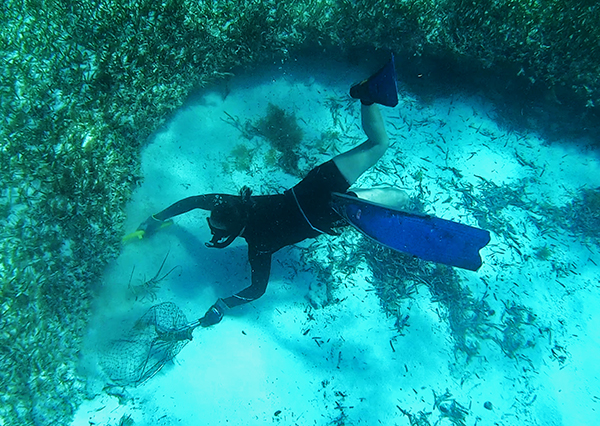
The regular season starts on August 6 and runs until March 31. In the Bahamas, there is no mini-season and their season runs from August 1 to March 31. Always make sure to study all regulations beforehand. There are closed zones and other quirky rules that can get you fined or worse if
you break them.
While the Florida Keys gets crowded during the mini-season, it’s also one of the best opportunities to catch lobster in the most accessible places, and often, they will be shoulder-to-shoulder in shallow water for easy pickings. On the first day, the season begins at daybreak in the Keys and savvy hunters will have scouted out the best areas and will be in position just as the sun comes up so this isn’t the day to sleep in.
Elsewhere in Florida, places like Fort Lauderdale, Jupiter and Vero Beach hold a few advantages such as being able to dive for lobster at night and during mini-season being able to keep 12 a day per person as opposed to the six a day max in the Keys. Plus, the lobster there, while not as numerous, are often larger due to fewer people hunting for them outside of Monroe County.
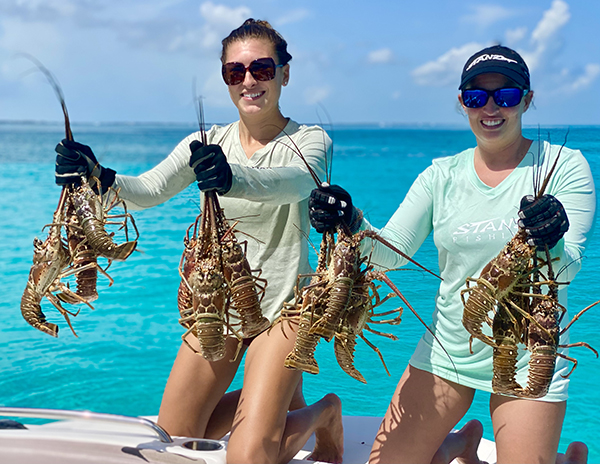
Where to Find Them
During the day, lobster hide and will back into any place that offers refuge. Look for any place that has structure such as coral, rocks, grassy overhangs or man made debris such as boat wrecks. Snorkeling is the sportiest way to catch them (lobster harvesting while scuba diving is illegal in the Bahamas) so finding them in the shallowest water makes it far easier.
Popular places in the Keys include the waters around the Seven Mile Bridge and along the rocky shorelines adjacent to US 1. An often overlooked place is around the mangrove-lined creeks and islands. On the Florida Bay side, small rocky patch reefs are abundant and often hold “bugs.”
A great way to prospect for lobster is to tow a snorkeler behind the boat at idle speed to help cover a lot of territory. Just make sure whenever you have anyone in the water to fly a diver-down flag.
So how do you find a lobster if they like to hide? Their long antennae usually give away their location. After you train your eyes to look for this visual cue, you get surprisingly adept at locating them.
Gear Needed to Catch Spiny Lobster
The two main tools to help catch lobster are the tickle stick and a snare pole with a loop on the end. Most hunters use a tickle stick, which is either a straight, slender fiberglass pole or an aluminum rod with a bend toward the end. This is used to tap on the back of a lobster to make it think something is sneaking up from behind. The stick with the bend is particularly useful for helping to scoot a lobster out of its hidey-hole.
After tapping the lobster out of its lair, position the net behind the bug and then over the top, pinning it to the bottom, because when confronted with danger, they will flip their tail and scoot backward rapidly into the back of the net. Then, use a gloved hand to grab the lobster over the net. If you don’t use a glove, you’ll quickly learn the hard way why they are called spiny lobster.
Next, while in the water, measure the lobster by placing the gauge between the twin horns on the head and if the back part of the gauge gap won’t fit over the back of the carapace or hard section containing the head, it’s legal. Lobsters caught in the U.S. must have a carapace 3 inches or greater. In the Bahamas, they must be at least 3 ⅜ inches. In all locations, egg-bearing females must be released.
How to Clean Lobster
The most common method is to simply twist the tail off the carapace but this wastes a significant amount of meat found in the head. Instead, take a sharp, flexible boning knife and insert the knife into where the carapace meets the tail section, with the knife tip facing the head. Start at the top and insert the knife as far as it will go and cut all around the contour.
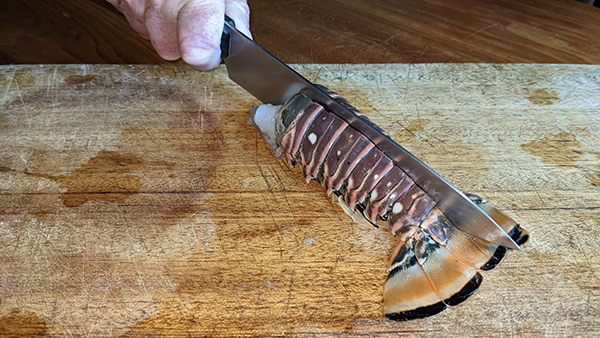
The intestinal tract needs to be pulled out but fortunately, nature has the perfect tool. Just snap off the end of an antenna and insert the fatter end into the opening at the tail’s base and the spines grab it for easy removal. The fattest part of the antenna also holds a nice morsel of meat.
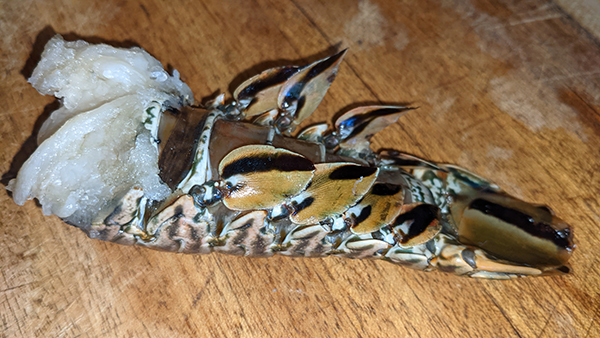
How not to Overcook Lobster
After all the time, money and effort expended to collect lobster, one of the worst disasters that can occur is to sit down to enjoy your bounty and find a platter of rubbery, tasteless tails. But fortunately, nature also has the perfect tool to prevent this.
If you look on both sides of the bottom of a spiny lobster tail, you’ll see a series of small, leaf like finlets, called swimmerets. These are your keys to nailing the cook on tails you cook on the grill.
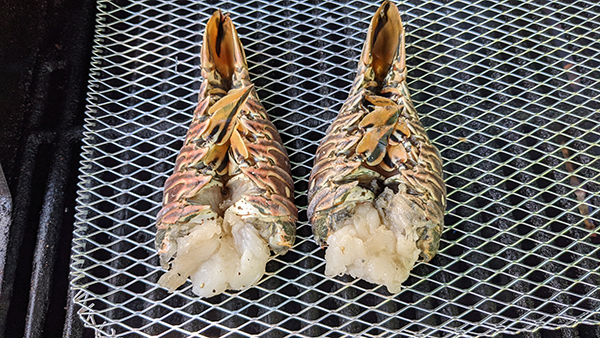.jpg)
To prepare the tail for cooking, lay it belly side down on a cutting board and use a sharp, heavy chef’s knife to split it, taking care not to cut all the way through. Fan the tail open so the meat sides lay flat and brush with butter and season with salt and pepper or Cavender’s Greek Seasoning. Toss the tail, meat side down, on a medium-heat grill and after five minutes or so give it a peek. If it has some color, flip it onto its back and drizzle the meat with more butter. After a few minutes, start feeling the swimmerets and when they start to feel stiff, take the tails off the grill and serve immediately with drawn butter and lemon juice. The beauty of this trick is larger tails have larger swimmerets so it’s self-regulating for size.
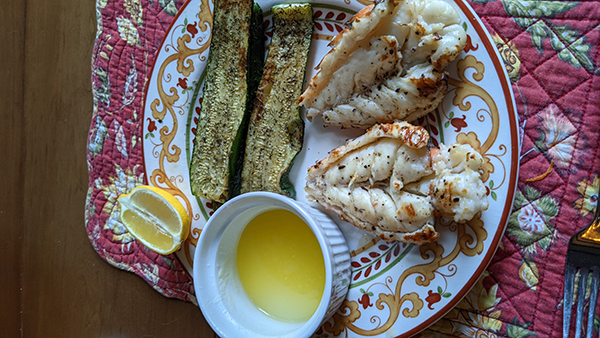
Catching lobster is one of those adventures that will create lifelong memories for your family.
Back to Blue Life
In Florida, the two-day spiny lobster mini-season always begins on the last consecutive Wednesday and Thursday of July, which in 2022 falls on July 26-27.

The regular season starts on August 6 and runs until March 31. In the Bahamas, there is no mini-season and their season runs from August 1 to March 31. Always make sure to study all regulations beforehand. There are closed zones and other quirky rules that can get you fined or worse if
you break them.
While the Florida Keys gets crowded during the mini-season, it’s also one of the best opportunities to catch lobster in the most accessible places, and often, they will be shoulder-to-shoulder in shallow water for easy pickings. On the first day, the season begins at daybreak in the Keys and savvy hunters will have scouted out the best areas and will be in position just as the sun comes up so this isn’t the day to sleep in.
Elsewhere in Florida, places like Fort Lauderdale, Jupiter and Vero Beach hold a few advantages such as being able to dive for lobster at night and during mini-season being able to keep 12 a day per person as opposed to the six a day max in the Keys. Plus, the lobster there, while not as numerous, are often larger due to fewer people hunting for them outside of Monroe County.

Where to Find Them
During the day, lobster hide and will back into any place that offers refuge. Look for any place that has structure such as coral, rocks, grassy overhangs or man made debris such as boat wrecks. Snorkeling is the sportiest way to catch them (lobster harvesting while scuba diving is illegal in the Bahamas) so finding them in the shallowest water makes it far easier.
Popular places in the Keys include the waters around the Seven Mile Bridge and along the rocky shorelines adjacent to US 1. An often overlooked place is around the mangrove-lined creeks and islands. On the Florida Bay side, small rocky patch reefs are abundant and often hold “bugs.”
A great way to prospect for lobster is to tow a snorkeler behind the boat at idle speed to help cover a lot of territory. Just make sure whenever you have anyone in the water to fly a diver-down flag.
So how do you find a lobster if they like to hide? Their long antennae usually give away their location. After you train your eyes to look for this visual cue, you get surprisingly adept at locating them.
Gear Needed to Catch Spiny Lobster
- Tickle stick or snare
- Gloves
- Short-handled net
- Measuring gauge
- Mesh collection bag
- Florida fishing license with a lobster stamp
- Diver-down flag
The two main tools to help catch lobster are the tickle stick and a snare pole with a loop on the end. Most hunters use a tickle stick, which is either a straight, slender fiberglass pole or an aluminum rod with a bend toward the end. This is used to tap on the back of a lobster to make it think something is sneaking up from behind. The stick with the bend is particularly useful for helping to scoot a lobster out of its hidey-hole.
After tapping the lobster out of its lair, position the net behind the bug and then over the top, pinning it to the bottom, because when confronted with danger, they will flip their tail and scoot backward rapidly into the back of the net. Then, use a gloved hand to grab the lobster over the net. If you don’t use a glove, you’ll quickly learn the hard way why they are called spiny lobster.
Next, while in the water, measure the lobster by placing the gauge between the twin horns on the head and if the back part of the gauge gap won’t fit over the back of the carapace or hard section containing the head, it’s legal. Lobsters caught in the U.S. must have a carapace 3 inches or greater. In the Bahamas, they must be at least 3 ⅜ inches. In all locations, egg-bearing females must be released.
How to Clean Lobster
The most common method is to simply twist the tail off the carapace but this wastes a significant amount of meat found in the head. Instead, take a sharp, flexible boning knife and insert the knife into where the carapace meets the tail section, with the knife tip facing the head. Start at the top and insert the knife as far as it will go and cut all around the contour.

The intestinal tract needs to be pulled out but fortunately, nature has the perfect tool. Just snap off the end of an antenna and insert the fatter end into the opening at the tail’s base and the spines grab it for easy removal. The fattest part of the antenna also holds a nice morsel of meat.

How not to Overcook Lobster
After all the time, money and effort expended to collect lobster, one of the worst disasters that can occur is to sit down to enjoy your bounty and find a platter of rubbery, tasteless tails. But fortunately, nature also has the perfect tool to prevent this.
If you look on both sides of the bottom of a spiny lobster tail, you’ll see a series of small, leaf like finlets, called swimmerets. These are your keys to nailing the cook on tails you cook on the grill.
.jpg)
To prepare the tail for cooking, lay it belly side down on a cutting board and use a sharp, heavy chef’s knife to split it, taking care not to cut all the way through. Fan the tail open so the meat sides lay flat and brush with butter and season with salt and pepper or Cavender’s Greek Seasoning. Toss the tail, meat side down, on a medium-heat grill and after five minutes or so give it a peek. If it has some color, flip it onto its back and drizzle the meat with more butter. After a few minutes, start feeling the swimmerets and when they start to feel stiff, take the tails off the grill and serve immediately with drawn butter and lemon juice. The beauty of this trick is larger tails have larger swimmerets so it’s self-regulating for size.

Catching lobster is one of those adventures that will create lifelong memories for your family.
Back to Blue Life
